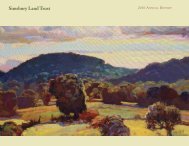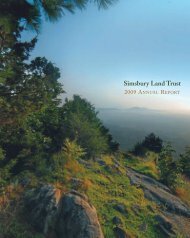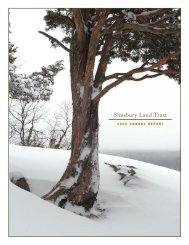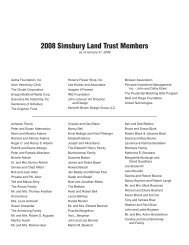The Walkbook - Simsbury Land Trust
The Walkbook - Simsbury Land Trust
The Walkbook - Simsbury Land Trust
Create successful ePaper yourself
Turn your PDF publications into a flip-book with our unique Google optimized e-Paper software.
28<br />
BOG WALK<br />
Location<br />
Start at two stone pillars 0.25 miles down North Saddle Ridge on the right.<br />
Distance<br />
1 mile round trip<br />
Terrain<br />
Flat, with a steep downhill path<br />
to the 150-foot wooden boardwalk<br />
over the bog.<br />
SLT<br />
Features<br />
This hike takes you out on a wide, flat trail along an esker (large deposit<br />
of glacial gravel left by the last Ice Age 10,000 years ago) to a boardwalk<br />
that stretches out into the bog. <strong>The</strong> <strong>Simsbury</strong> <strong>Land</strong> <strong>Trust</strong> constructed the<br />
short, elevated walkway to enable people to view the habitat up close.<br />
You will see a series of educational signs touching on the unique ecosystem<br />
found here. Watch for signs marking the entrance to the bog walk<br />
on the right side. Although common in northern New England and<br />
Canada, bogs are far less so in Connecticut, and this is the only sizeable<br />
bog habitat in <strong>Simsbury</strong>. <strong>The</strong> water supply for this 40-acre bog comes<br />
only from rainwater and underground springs and is poor in oxygen and<br />
nutrients. <strong>The</strong> high acidity of bog water interferes with a plant’s ability to<br />
absorb both water and nutrients. This creates a habitat very different<br />
from that of the swamp to the north of the esker. Best known for their<br />
sphagnum moss, which “floats” on the water, bogs are also home to a<br />
number of plants and animals seldom found in the more common red<br />
maple swamps. Characteristic leatherleaf plants contribute to the mat<br />
while highbush blueberries and swamp azaleas are specially adapted for<br />
this environment and thrive on the edges. Small maples are even seen<br />
growing on the mat of moss. Other plants found in this bog include red<br />
chokeberry, common bog cotton, and three-way sedge. Few animals live<br />
in the bog, although many pass through it in search of food or shelter.<br />
Permanent residents include insect-eating birds, garter snakes, frogs, and<br />
turtles that feed on large insects. While relaxing on the boardwalk, enjoy<br />
a fine view of West Mountain.<br />
N Saddle Ridge Dr<br />
Lenora Dr.<br />
Town<br />
Open<br />
Space<br />
SLT<br />
Bog<br />
Old Farms Rd<br />
29







